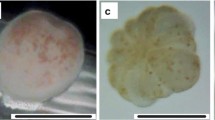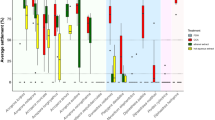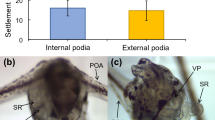Abstract
Bacterial biofilms are increasingly seen as important for the successful settlement of marine invertebrate larvae. Here we tested the effects of biofilms on settlement of the sea urchin Heliocidaris erythrogramma. Larvae settled on many surfaces including various algal species, rocks, sand and shells. Settlement was reduced by autoclaving rocks and algae, and by treatment of algae with antibiotics. These results, and molecular and culture-based analyses, suggested that the bacterial community on plants was important for settlement. To test this, approximately 250 strains of bacteria were isolated from coralline algae, and larvae were exposed to single-strain biofilms. Many induced rates of settlement comparable to coralline algae. The genus Pseudoalteromonas dominated these highly inductive strains, with representatives from Vibrio, Shewanella, Photobacterium and Pseudomonas also responsible for a high settlement response. The settlement response to different bacteria was species specific, as low inducers were also dominated by species in the genera Pseudoalteromonas and Vibrio. We also, for the first time, assessed settlement of larvae in response to characterised, monospecific biofilms in the field. Larvae metamorphosed in higher numbers on an inducing biofilm, Pseudoalteromonas luteoviolacea, than on either a low-inducing biofilm, Pseudoalteromonas rubra, or an unfilmed control. We conclude that the bacterial community on the surface of coralline algae is important as a settlement cue for H. erythrogramma larvae. This study is also an example of the emerging integration of molecular microbiology and more traditional marine eukaryote ecology.








Similar content being viewed by others
References
Abelson A, Denny M (1997) Settlement of marine organisms in flow. Annu Rev Ecol Syst 28:317–339
Altschul SF, Gish W, Miller W, Myers EE, Lipman DJ (1990) Basic local alignment search tool. J Mol Biol 215:403–410
Anderson MJ, Underwood AJ (1997) Effects of gastropod grazers on recruitment and succession of an estuarine assemblage: a multivariate and univariate approach. Oecologia 109:442–453
Barbieri E et al (2001) Phylogenetic characterization of epibiotic bacteria in the accessory nidamental gland and egg capsules of the squid Loligo peali (Cephalopoda: Loliginidae). Environ Microbiol 3:151–167
Boettcher AA, Targett NM (1998) Role of chemical inducers in larval metamorphosis of queen conch, Strombus gigas Linnaeus: relationship to other marine invertebrate systems. Biol Bull 194:132–142
Boxshall AJ (2000) The importance of flow and settlement cues to larvae of the abalone, Haliotis rufescens Swainson. J Exp Mar Biol Ecol 254:143–167
Browne KA, Zimmer RK (2001) Controlled release of a waterborne chemical signal stimulates planktonic larvae to settle. Biol Bull 200:87–91
Burke RD (1984) Pheromonal control of metamorphosis in the sand dollar, Dendraster excentricus. Science 225:442–443
Burke RD (1986) Pheromones and the gregarious settlement of marine invertebrate larvae. Bull Mar Sci 39:584–593
Butman CA (1987) Larval settlement of soft-sediment invertebrates: the spatial scales of pattern explained by active habitat selection and the emerging role of hydrodynamical processess. Oceanogr Mar Biol Annu Rev 25:113–165
Caley MJ, Carr ME, Hixon MA, Hughes TP, Jones GP, Menge BA (1996) Recruitment and the local dynamics of open marine populations. Annu Rev Ecol Syst 27:477–500
Callow ME et al (2002) Microtopographic cues for settlement of zoospores of the green fouling alga Enteromorpha. Biofouling 18:237–245
Clarke KR, Warwick RM (1994) Change in marine communities: an approach to statistical analysis and interpretation. Plymouth Marine Laboratory, Plymouth
Dahllöf I, Baillie H, Kjelleberg S (2000) rpoB-based microbial community analysis avoids limitations inherent in 16S rRNA gene intraspecies heterogeneity. Appl Environ Microbiol 66:3376–3380
Dahms H-U, Dobretsov S, Qian P-Y (2004) The effect of bacterial and diatom biofilms on the settlement of the bryozoan Bugula neritina. J Exp Mar Biol Ecol 313:191–209
Daume S, Brand-Gardner S, Woelkerling WJ (1999) Settlement of abalone larvae (Haliotis laevigata Donovan) in response to non-geniculate coralline red algae (Corallinales, Rhodophyta). J Exp Mar Biol Ecol 234:125–143
Daume S, Krsinich A, Farrell S, Gervis M (2000) Settlement, early growth and survival of Haliotis rubra in response to different algal species. J Appl Phycol 12:479–488
Fusetani N (1997) Marine natural products influencing larval settlement and metamorphosis of benthic invertebrates. Curr Org Chem 1:127–115
Gallardo WG, Buen SA (2003) Evaluation of mucus, Navicula, and mixed diatoms as larval settlement inducers for the tropical abalone Haliotis asinina. Aquaculture 221:357–364
Gordon N, Shpigel M, Harpaz S, Lee JJ, Neori A (2004) The settlement of abalone (Haliotis discus hannai) larvae on culture layers of different diatoms. J Shellfish Res 23:561–568
Gosselin P, Jangoux M (1996) Induction of metamorphosis in Paracentrotus lividus larvae (Echinodermata, Echinoidea). Oceanol Acta 19:293–296
Hadfield MG, Paul VJ (2001) Natural chemical cues for settlement and metamorphosis of marine invertebrate larvae. In: McClintock JB, Baker JB (eds) Marine chemical ecology. CRC, Boca Raton, Fla., pp 431–461
Harder T, Lam C, Qian PY (2002) Induction of larval settlement in the polychaete Hydroides elegans by marine biofilms: an investigation of monospecific diatom films as settlement cues. Mar Ecol Prog Ser 229:105–112
Hentschel U, Schmid M, Wagner M, Fieseler L, Gernert C, Hacker J (2001) Isolation and phylogenetic analysis of bacteria with antimicrobial activities from the Mediterranean sponges Aplysina aerophoba and Aplysina cavernicola. FEMS Microbiol Ecol 35:305–312
Hofmann DK, Brand U (1987) Induction of metamorphosis in the symbiotic Scyphozoan Cassiopea andromeda: role of marine bacteria and biochemicals. Symbiosis 4:99–116
Holmström C, Kjelleberg S (1999) Marine Pseudoalteromonas species are associated with higher organisms and produce biologically active extracellular agents. FEMS Microbiol Ecol 30:285–293
Holmström C, Kjelleberg S (2000) Bacterial interactions with marine fouling organisms. In: Evans LV (eds) Biofilms: recent advances in their study and control. Harwood Academic Publishers, Australia, pp 101–115
Holmström C, Rittschof D, Kjelleberg S (1992) Inhibition of settlement by larvae of Balanus amphitrite and Ciona intestinalis by a surface-colonizing marine bacterium. Appl Environ Microbiol 58:2111–2115
Huang S, Hadfield MG (2003) Composition and density of bacterial biofilms determine larval settlement of the polycheate Hydroides elegans. Mar Ecol Prog Ser:161–172
Huggett MJ, de Nys R, Williamson JE, Heasman M, Steinberg PD (2005) Settlement of larval blacklip abalone, Haliotis rubra, in response to red and green macroalgae. Mar Biol 147:1155–1163
Johnson CR, Sutton DC (1994) Bacteria on the surface of crustose coralline algae induce metamorphosis of the crown-of-thorns starfish Acanthaster planci. Mar Biol 120:305–310
Johnson CR, Muir DG, Reysenbach AL (1991a) Characteristic bacteria associated with surfaces of coralline algae: a hypothesis for bacterial induction of marine invertebrate larvae. Mar Ecol Prog Ser 74:281–294
Johnson CR, Sutton DC, Olson RR, Giddins R (1991b) Settlement of crown-of-thorns starfish: role of bacteria on surfaces of coralline algae and hypothesis of deep water recruitment. Mar Ecol Prog Ser 71:143–162
Keesing JK (2001) The ecology of Heliocidaris erythrogramma. In: Lawrence JM (eds) Edible sea urchins: biology and ecology. Elsevier, New York, pp 261–270
Keough MJ, Raimondi PT (1995) Responses of settling invertebrate larvae to bioorganic films: effects of different types of films. J Exp Mar Biol Ecol 185:235–253
Kobak J (2001) Light, gravity and conspecifics as cues to site selection and attachment behaviour of juvenile and adult Dreissena polymorpha Pallas, 1771. J Mollusc Stud 67:183–189
Krug PJ (2001) Bet-hedging dispersal strategy of a specialist marine herbivore: settlement dimorphism among sibling larvae of Alderia modesta. Mar Ecol Prog Ser 213:177–192
Krug PJ, Manzi AE (1999) Waterborne and surface-associated carbohydrates as settlement cues for larvae of the specialist marine herbivore Alderia modesta. Biol Bull 197:94–103
Lamare MD, Barker MF (2001) Settlement and recruitment of the New Zealand sea urchin Evechinus chloroticus. Mar Ecol Prog Ser 218:153–166
Lau SK, Qian PY (2001) Larval settlment in the serpulid polycheate Hydroides elegans in response to bacterial films: an investigation of the nature of putitative larval settlement cue. Mar Biol 138:321–328
Lau SCK, Mak KKW, Chen F, Qian PY (2002) Bioactivity of bacterial strains isolated from marine biofilms in Hong Kong waters for the induction of larval settlement in the marine polychaete Hydroides elegans. Mar Ecol Prog Ser 226:301–310
Lau SCK, Harder T, Qian P (2003) Induction of larval settlement in the serpulid polycheate Hydroides elegans (Haswell): role of bacterial extracellular polymers. Biofouling 19:197–204
Lau SCK, Thiyagarajan V, Cheung SCK, Qian P-Y (2005) Roles of bacterial community composition in biofilms as a mediator for larval settlement of three marine invertebrates. Aquat Microb Ecol 38:41–51
Leitz T (1997) Induction and metamorphosis of cnidarian larvae: signals and signal transduction. Invertebr Reprod Dev 31:109–122
Morse AC (1992) Role of algae in the recruitment of marine invertebrate larvae. In: John DM, Hawkins SJ, Price JH (eds) Plant–animal interactions in the marine benthos, vol 46. Clarendon Press, Oxford, pp 385–403
Morse ANC, Froyd CA, Morse DE (1984) Molecules from cyanobacteria and red algae that induce settlement and metamorphosis in the mollusc Haliotis rufescens. Mar Biol 81:293–298
Neal AL, Yule AB (1994) The interaction between Elminius modestus Darwin cyprids and biofilms of Deleya marina Ncmb1877. J Exp Mar Biol Ecol 176:127–139
Negri AP, Webster NS, Hill RT, Heyward AJ (2001) Metamorphosis of broadcast spawning corals in response to bacteria isolated from crustose algae. Mar Ecol Prog Ser 223:121–131
Patil JS, Anil AC (2005) Influence of diatom exoploymers and biofilms on metamorphosis in the barnacle Balanus amphitrite. Mar Ecol Prog Ser 301:231–245
Pawlik JR (1992) Chemical ecology of the settlement of marine invertebrates. Oceanogr Mar Biol Annu Rev 30:273–335
Pearce CM, Scheibling RE (1991) Effect of macroalgae, microbial films, and conspecifics on the induction of metamorphosis of the green sea urchin Strongylocentrotus droebachiensis (Muller). J Exp Mar Biol Ecol 147:147–162
Pechenik JA (1999) On the advantages and disadvantages of larval stages in benthic marine invertebrate life cycles. Mar Ecol Prog Ser 177:269–297
Prescott LM, Harley JP, Klein DA (1995) Microbiology, 3rd edn. Brown, Dubuque
Raimondi PT, Morse ANC (2000) The consequences of complex larval behaviour in a coral. Ecology 81(11):3193–3211
Roberts R (2001) A review of settlement cues for larval abalone (Haliotis spp.). J Shellfish Res 20:571–586
Rodriguez SR, Ojeda FP, Inestrosa NC (1993) Settlement of benthic marine invertebrates. Mar Ecol Prog Ser 97:193–207
Rodriguez SR, Riquelme C, Campos EO, Chavez P, Brandan E, Inestrosa NC (1995) Behavioral responses of Concholepas concholepas (Bruguiere, 1789) larvae to natural and artificial settlement cues and microbial films. Biol Bull 189:272–279
Steinberg PD, de Nys R (2002) Chemical mediation of colonization of seaweed surfaces. J Phycol 38:621–629
Steinberg PD, de Nys R, Kjelleberg S (2001) Chemical mediation of surface colonization. In: McClintock JB, Baker BJ (eds) Marine chemical ecology. CRC, Boca Raton, Fla., pp 355–387
Swanson RL, Williamson JE, de Nys R, Kumar N, Bucknall MP, Steinberg PD (2004) Induction of settlement of larvae of the sea urchin Holopneustes purpurascens by histamine from a host alga. Biol Bull 206:161–172
Switzer-Dunlap M (1978) Larval biology and metamorphosis of Aplysiid gastropods. In: Chia F-S, Rice ME (eds) Settlement and metamorphosis of marine invertebrate larvae. Elsevier, New York, pp 197–206
Switzer-Dunlap M, Hadfield M (1977) Observations on development, larval growth and metamorphosis of four species of Aplysiidae (Gastropa: Opisthobranchia) in laboratory culture. J Exp Mar Biol Ecol 29:245–261
Szewzyk U, Holstrom C, Wrangstadh M, Samuelsson M-O, Maki JS, Kjelleberg S (1991) Relevance of the exopolysaccharide of marine Pseudomonas sp. strain S9 for the attachment of Ciona intestinalis larvae. Mar Ecol Prog Ser 75:259–265
Thompson RC, Roberts MF, Norton TA, Hawkins SJ (2000) Feast or famine for intertidal grazing molluscs: a mis-match between seasonal variations in grazing intensity and the abundance of microbial resources. Hydrobiologia 440:357–367
Thorson G (1950) Reproductive and larval ecology of marine bottom invertebrates. Biol Rev 25:1–45
Towbridge CD (1992) Phenology and demography of a marine specialist herbivore: Placida dendritica (Gastropoda: Opisthobrancha) on the central coast of Oregon. Mar Biol 114:443–452
Unabia CRC, Hadfield MG (1999) Role of bacteria in larval settlement and metamorphosis of the polychaete Hydroides elegans. Mar Biol 133:55–64
Underwood AJ, Keough MJ (2000) Supply-side ecology: the nature and consequences of variations in recruitment of intertidal organisms. In: Bertness MD, Gaines SD, Hay ME (eds) Marine community ecology. Sinauer, Sunderland, Mass., pp 183–200
Webster NS, Smith LD, Heyward AJ, Watts JEM, Webb RI, Blackall LL, Negri AJ (2004) Metamorphosis of a scleractinian coral in response to microbial biofilms. Appl Environ Microbiol 70:1213–1221
Weiner RM, Williams N, Birch G, Ramachandran C, Collwell RR (1989) Effect of biofilms of the marine bacterium Alteromonas colwelliana (LST) on set of oysters Crassostrea gigas Thunberg 1793 and Crassostrea virginica Gmelin 1791. J Shellfish Res 8:117–124
Wieczorek SK, Todd CD (1998) Inhibition and facilitation of settlement of epifaunal marine invertebrate larvae by microbial biofilm cues. Biofouling 12:81–118
Wilkinson L (1997) SYSTAT 7.0. SPSS, Chicago, Ill.
Williams DHC, Anderson DT (1975) The reproductive system, embryonic development, larval development and metamorphosis of the sea urchin Heliocidaris erythrogramma (Val.) (Echinoidea: Echinometridae). Aust J Zool 23:371–403
Williamson JE, de Nys R, Kumar N, Carson DG, Steinberg PD (2000) Induction of metamorphosis in the sea urchin Holopneustes purpurascens by a metabolite complex from the algal host Delisea pulchra. Biol Bull 198:332–345
Xue-wu L, Gordon ME (1987) Tissue and cell culture of New Zealand Pterocladia and Porphyra species. Hydrobiologia 151/152:147–154
Zhao B, Qian PY (2002) Larval settlement and metamorphosis in the slipper limpet Crepidula onyx (Sowerby) in response to conspecific cues and the cues from biofilm. J Exp Mar Biol Ecol 269:39–51
Zobell CE, Allen EC (1935) The significance of marine bacteria in the fouling of submerged surfaces. J Bacteriol 29:230–251
Acknowledgements
This research was supported by an Australian Postgraduate Award to M. J. H., an ARC Large Grant to P. D. S. and R. d. N., and the Centre for Marine Biofouling and BioInnovation. We thank Sabine Daume and Sylvain Hutchette for Ulvella lens' cultures and Rebecca Swanson, Sharon Longford, Mike Taylor and Carola Holmström for assistance in the laboratory and field. Three anonymous reviewers provided helpful comments to improve the manuscript.
Author information
Authors and Affiliations
Corresponding author
Additional information
Communicated by Martin Attrill
Rights and permissions
About this article
Cite this article
Huggett, M.J., Williamson, J.E., de Nys, R. et al. Larval settlement of the common Australian sea urchin Heliocidaris erythrogramma in response to bacteria from the surface of coralline algae. Oecologia 149, 604–619 (2006). https://doi.org/10.1007/s00442-006-0470-8
Received:
Accepted:
Published:
Issue Date:
DOI: https://doi.org/10.1007/s00442-006-0470-8




